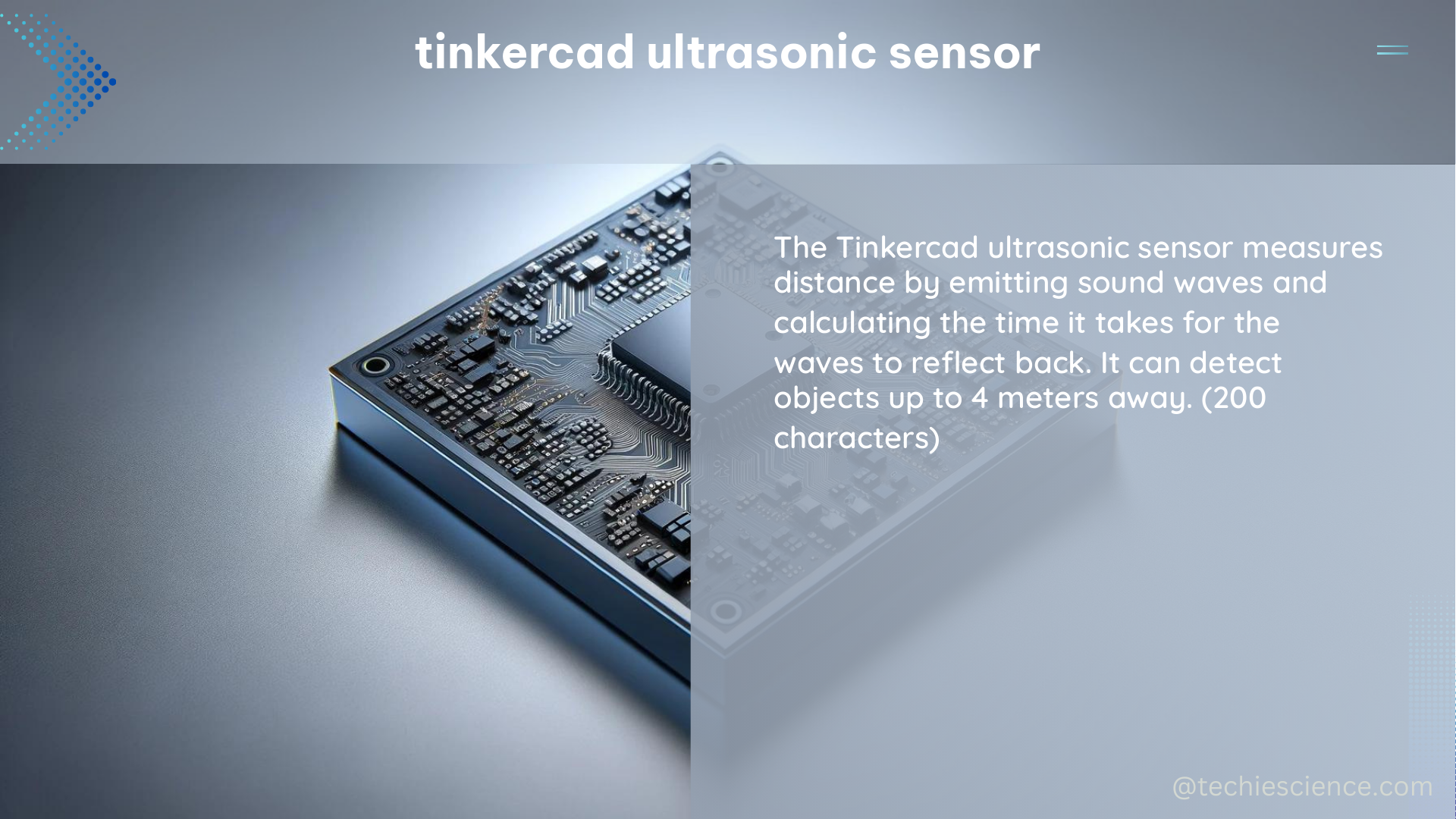The Tinkercad Ultrasonic Sensor, specifically the HCSR04 model, is a crucial component in distance measurement for robotics and automation projects. This sensor consists of two primary parts: a transmitter that emits ultrasonic sound waves and a receiver that captures the reflected signal, enabling precise distance detection and measurement.
Technical Specifications of the HCSR04 Ultrasonic Sensor
The HCSR04 Ultrasonic Sensor boasts the following impressive technical specifications:
| Specification | Value |
|---|---|
| Operating Voltage | 5V to 20V (recommended 5V) |
| Current Consumption | Approximately 15mA |
| Operating Frequency | 40kHz |
| Measurement Range | 2cm to 400cm |
| Accuracy | ±3mm (up to 100cm), ±5mm (beyond 100cm) |
| Angle of Emission | 15 degrees |
| Response Time | 60ms |
These specifications make the HCSR04 Ultrasonic Sensor a versatile and reliable choice for a wide range of DIY projects, from obstacle-avoiding robots to automated systems.
Tinkercad Integration: Simulating and Prototyping with Ease

Tinkercad provides a user-friendly platform for simulating and prototyping electronic circuits, including those involving the HCSR04 Ultrasonic Sensor. The platform offers a vast library of components, including the Arduino Uno, Ultrasonic Sensor, LEDs, resistors, and more. By integrating the sensor with the Arduino Uno, users can create exciting projects, such as:
- Obstacle-Avoiding Robots: The ultrasonic sensor can be used to detect obstacles in the robot’s path, allowing it to navigate safely and autonomously.
- Automated Lighting Systems: The sensor can be used to detect the presence of people or objects, triggering the activation of lights or other devices.
- Distance Measurement Applications: The sensor’s precise distance measurement capabilities can be utilized in various applications, such as level monitoring, proximity detection, and more.
Arduino IDE Integration: Unlocking Advanced Programming Capabilities
Tinkercad’s seamless integration with the Arduino IDE allows users to write and upload custom code to the Arduino board. This integration enables fine-tuning of projects and exploration of advanced programming concepts, such as:
- Sensor Calibration: Adjusting the sensor’s sensitivity and response time to optimize its performance for specific applications.
- Data Processing and Visualization: Implementing algorithms to process the sensor’s data and display the results on a connected display or computer.
- Sensor Fusion: Combining the ultrasonic sensor with other sensors, such as infrared or laser, to enhance the accuracy and reliability of distance measurements.
Understanding the HCSR04 Ultrasonic Sensor Working Principle
The HCSR04 Ultrasonic Sensor operates by emitting high-frequency sound waves (40kHz) that travel at a speed faster than audible sound. When these waves encounter an obstacle, they are reflected back to the sensor. The sensor measures the time it takes for the sound waves to return and calculates the distance to the obstacle based on this time. This distance is then converted into an electric signal, which can be processed by a microcontroller like the Arduino Uno.
The sensor’s ability to measure distances ranging from 2cm to 400cm, with an accuracy of ±3mm up to 100cm and ±5mm beyond 100cm, makes it a reliable choice for a wide range of applications.
Tinkercad Ultrasonic Sensor DIY: A Step-by-Step Guide
To create a DIY project using the Tinkercad Ultrasonic Sensor, follow these detailed steps:
- Create a Tinkercad account: Sign up for a free account at Tinkercad.com.
- Access the Tinkercad dashboard: Log in to your account and access your dashboard.
- Create a new project: Click “Create new project” and choose a name for your project.
- Add components: Drag and drop the Arduino Uno, Ultrasonic Sensor, LEDs, resistors, and other necessary components onto the canvas.
- Connect the components: Wire the components according to the project’s requirements. Ensure that the Ultrasonic Sensor’s Trigger pin is connected to a digital pin on the Arduino Uno, and the Echo pin is connected to another digital pin.
- Write and upload code: In the Arduino IDE, write custom code to control the Ultrasonic Sensor and any other components in your project. Once the code is ready, upload it to the Arduino Uno board.
- Test and simulate: Test your project in the Tinkercad simulator and make any necessary adjustments to the code or circuit connections.
By following these steps, you can create a wide range of DIY projects using the Tinkercad Ultrasonic Sensor, from simple distance measurement applications to complex robotic systems.
References:
- Tinkercad – Ultrasonic Distance Sensor
- Learn Electronics India – How to Interface an Ultrasonic Sensor with Arduino Using Tinkercad
- Tinkercad Circuit to Measure Distance using Ultrasonic Sensor and Arduino
- Instructables – Ultrasonic Distance Sensor in Arduino With Tinkercad

The lambdageeks.com Core SME Team is a group of experienced subject matter experts from diverse scientific and technical fields including Physics, Chemistry, Technology,Electronics & Electrical Engineering, Automotive, Mechanical Engineering. Our team collaborates to create high-quality, well-researched articles on a wide range of science and technology topics for the lambdageeks.com website.
All Our Senior SME are having more than 7 Years of experience in the respective fields . They are either Working Industry Professionals or assocaited With different Universities. Refer Our Authors Page to get to know About our Core SMEs.